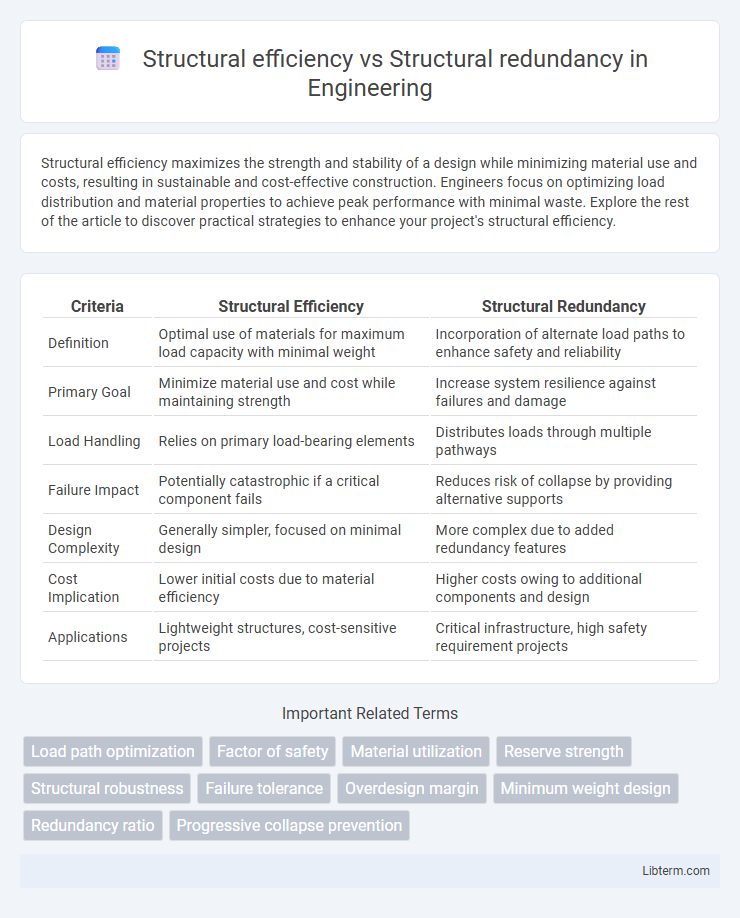Structural efficiency maximizes the strength and stability of a design while minimizing material use and costs, resulting in sustainable and cost-effective construction. Engineers focus on optimizing load distribution and material properties to achieve peak performance with minimal waste. Explore the rest of the article to discover practical strategies to enhance your project's structural efficiency.
Table of Comparison
| Criteria | Structural Efficiency | Structural Redundancy |
|---|---|---|
| Definition | Optimal use of materials for maximum load capacity with minimal weight | Incorporation of alternate load paths to enhance safety and reliability |
| Primary Goal | Minimize material use and cost while maintaining strength | Increase system resilience against failures and damage |
| Load Handling | Relies on primary load-bearing elements | Distributes loads through multiple pathways |
| Failure Impact | Potentially catastrophic if a critical component fails | Reduces risk of collapse by providing alternative supports |
| Design Complexity | Generally simpler, focused on minimal design | More complex due to added redundancy features |
| Cost Implication | Lower initial costs due to material efficiency | Higher costs owing to additional components and design |
| Applications | Lightweight structures, cost-sensitive projects | Critical infrastructure, high safety requirement projects |
Introduction to Structural Efficiency and Redundancy
Structural efficiency measures how effectively a structure uses materials to support loads with minimal weight and cost, optimizing strength-to-weight ratio and ensuring stability. Structural redundancy refers to incorporating extra elements beyond the minimum requirement, enhancing safety by providing alternative load paths in case of component failure. Balancing structural efficiency and redundancy is crucial for designing resilient and cost-effective buildings that can withstand unexpected stresses without compromising performance.
Defining Structural Efficiency in Engineering
Structural efficiency in engineering measures how effectively a structure uses material to withstand applied loads with minimal weight and cost. It emphasizes optimizing the design to achieve maximum strength and stability while reducing excess material and unnecessary complexity. This concept contrasts with structural redundancy, which involves incorporating extra elements to ensure safety despite potential component failures.
Understanding Structural Redundancy
Structural redundancy enhances building safety by incorporating multiple load paths, ensuring stability even if one element fails. Unlike structural efficiency, which aims to minimize material use for cost and weight savings, redundancy prioritizes resilience against unexpected stresses and damage. Understanding structural redundancy involves recognizing its role in distributing loads, preventing catastrophic collapse, and improving overall durability in engineering designs.
Key Differences Between Efficiency and Redundancy
Structural efficiency maximizes material use to achieve minimal weight and cost while maintaining required strength, optimizing load paths and member sizes for performance. Structural redundancy involves incorporating multiple load paths or extra members to ensure stability and safety in case of element failure, enhancing reliability but often increasing weight and expense. The key difference lies in efficiency prioritizing minimalism for optimal resource use, whereas redundancy emphasizes safety through backup systems, impacting design approaches and overall structural resilience.
Benefits of Structural Efficiency
Structural efficiency maximizes material use by optimizing load distribution, which reduces construction costs and minimizes environmental impact. It enhances performance by creating lightweight yet strong structures that require less maintenance over time. Improved design accuracy from efficient structures leads to faster construction and greater sustainability in engineering projects.
Advantages of Structural Redundancy
Structural redundancy enhances safety by providing multiple load paths, allowing a structure to sustain damage or component failure without collapsing. This resilience reduces the risk of catastrophic failure and extends the lifespan of critical infrastructure such as bridges, high-rise buildings, and offshore platforms. Incorporating redundancy improves maintenance flexibility, enabling repairs without compromising overall stability or functionality.
Challenges in Achieving Structural Efficiency
Achieving structural efficiency faces challenges such as balancing material optimization with safety requirements, where minimizing weight and cost can compromise load-bearing capacity. Designing for efficiency often reduces redundancy, increasing vulnerability to local failures that could propagate catastrophic collapse without alternative load paths. Engineers must integrate advanced analysis techniques and robust safety factors to ensure performance while addressing uncertainties in load conditions and material behavior.
Risks Associated with Excessive Redundancy
Excessive structural redundancy can increase risks by introducing complexity that complicates load distribution and damage detection, potentially masking hidden failures within interconnected components. This over-redundancy may result in inefficient material use, leading to increased costs and added weight without proportional safety benefits. Structural designs should balance redundancy to ensure safety and resilience while minimizing unnecessary risks associated with excessive overlapping load paths.
Finding the Optimal Balance: Efficiency vs. Redundancy
Structural efficiency maximizes material use and load-bearing capacity, minimizing weight and cost in engineering designs. Structural redundancy introduces alternative load paths to enhance safety and resilience against unexpected failures or damages. Finding the optimal balance involves integrating sufficient redundancy without compromising efficiency, ensuring robust structural performance while controlling material and construction expenses.
Real-World Applications and Case Studies
Structural efficiency maximizes material use by enabling minimal weight and cost while maintaining strength, exemplified in aerospace engineering where lightweight yet robust components are critical. Structural redundancy enhances safety by incorporating multiple load paths, as seen in bridge design, where alternative supports prevent collapse during damage or overload. Case studies such as the Tacoma Narrows Bridge failure highlight the consequences of prioritizing efficiency without adequate redundancy, while modern skyscrapers balance both to withstand natural disasters.
Structural efficiency Infographic

 libterm.com
libterm.com